This post may contain affiliate links. Please see our disclosure policy.
Canning spaghetti sauce turns an otherwise boring pasta night into a homemade feast! When you can your own, you’re able to add your own seasonings and customize it to your families taste, making it truly special.
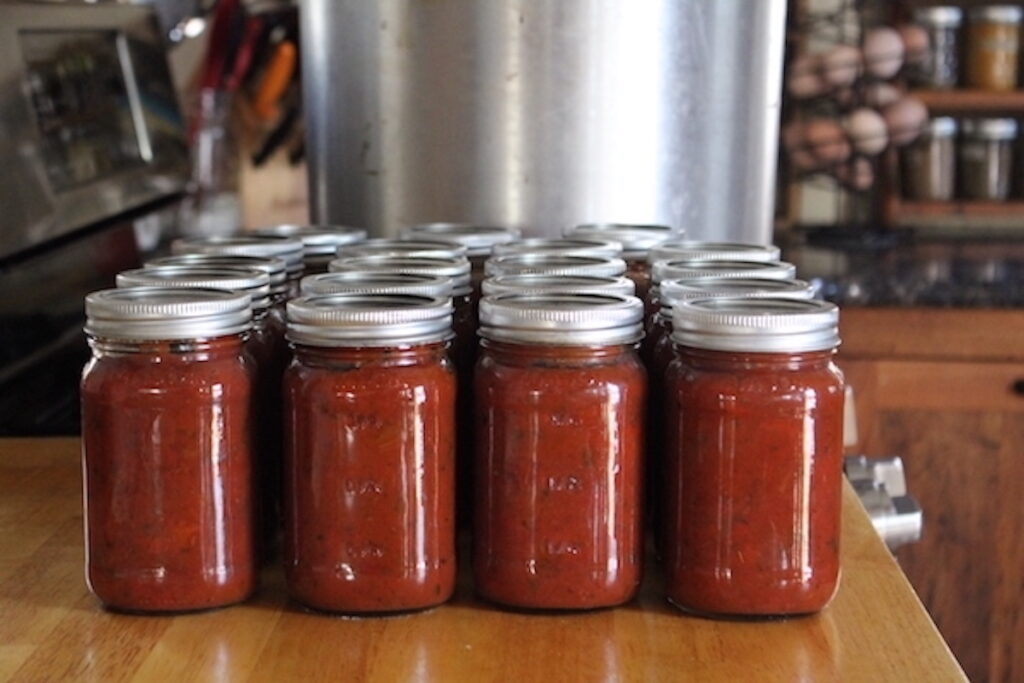
Table of Contents
- Pasta Sauce Canning Notes
- A Quick Look at the Recipe
- Ingredients for Spaghetti Sauce Without Meat
- Canning Spaghetti Sauce Without Meat
- Altitude Adjustments
- Serving Home Canned Pasta Sauce
- Canning Spaghetti Sauce (Basic Recipe without Meat)
- For dial gauge pressure canners:
- For weighted gauge pressure canners:
- Pressure Canning Recipes
- Meal in a Jar Canning Recipes
Canning spaghetti sauce without meat is a delicious and useful way to make the most of a veggie-based diet. It’s great for stocking your pantry for ready-made meals that come together in a cinch!
Whether you’re using canned tomatoes from the store or fresh ingredients you grew yourself, there are plenty of ways to whip up a hearty dinner without resorting to meat.
Plus, this spaghetti sauce can be just as tasty, if not more so, than classic spaghetti sauce recipes that contain ground beef or other meats.
After preparing it and opening a jar later on, you can use this sauce as a base for other recipes (including those with meat), or serve it all by itself for a super flavorful meal.
Pasta Sauce Canning Notes
This particular pasta sauce canning recipe was developed by the NCHFP as a pressure canning recipe, since it has plenty of onions and mushrooms to make it a hearty sauce. It cannot be processed in a waterbath canner.
I do have a full list of every tested pasta sauce canning recipe available, which includes 30 different recipes. Of those, a total of 19 are waterbath canning recipes.
The main difference is waterbath canning recipes either have significantly more added acidity (in the form of wine, balsamic vinegar or lemon juice) or they have fewer low acid vegetables (like peppers, onions and mushrooms). I also have a tested pressure canning recipe for spaghetti sauce with meat if you’d like a heartier sauce.
25+ Pasta Sauce Recipes For Canning
Spaghetti sauce recipes for canning are often hard to find, especially if you’re looking for water bath canning recipes. It’s…
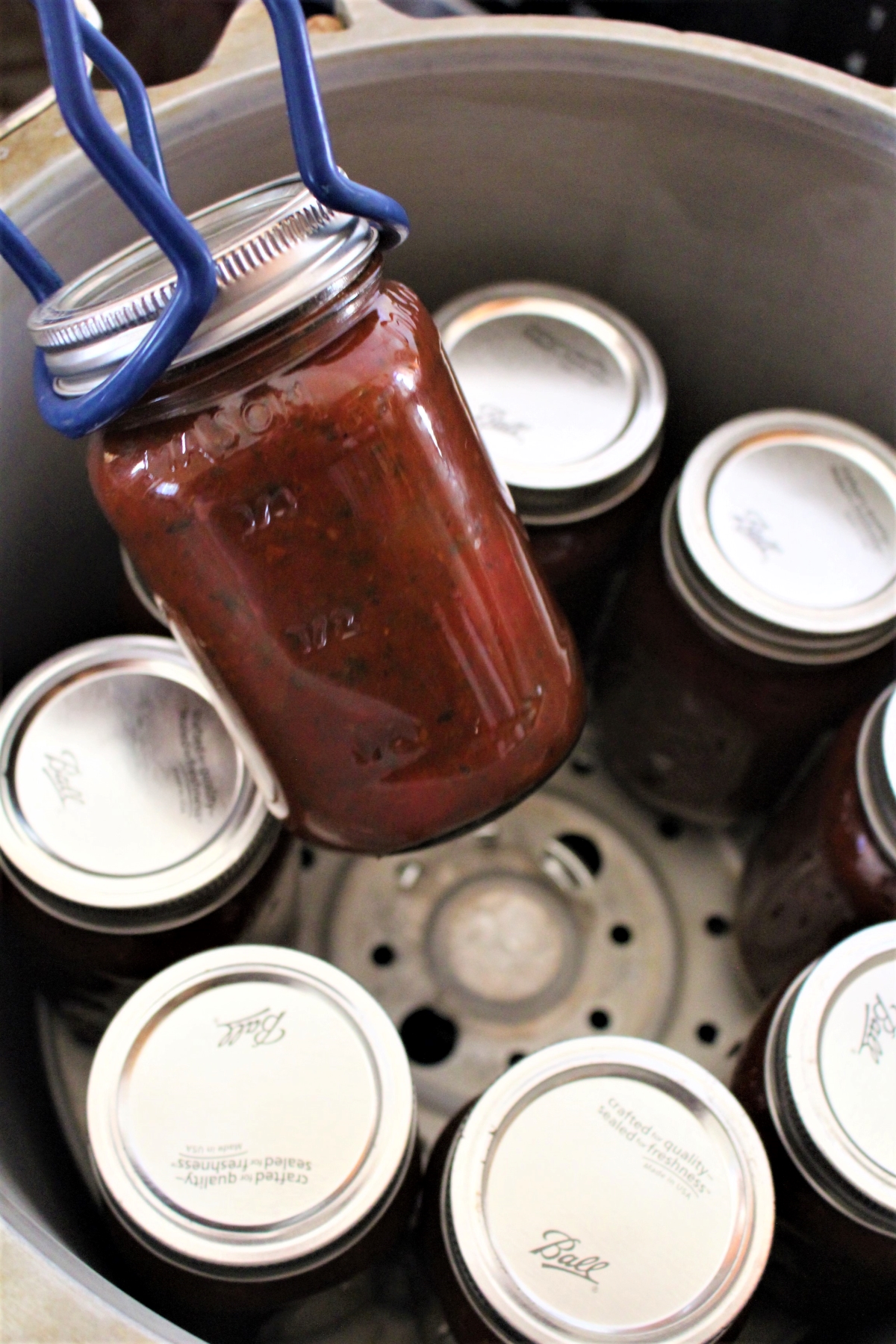
A Quick Look at the Recipe
- Recipe Name: Basic Hearty Pasta Sauce (No Meat)
- Recipe Type: Pasta Sauce (Tomato Sauce)
- Canning Method: Pressure Canning
- Prep/Cook Time: 1 hour to 1 1/2 hours
- Canning Time: 25 Minutes
- Yield: 4 to 5 quarts
- Jar Sizes: Quarter Pint, Half Pint, Pint and Quart
- Headspace: 1/2 inch
- Ingredients Overview: Tomatoes, Onions, Peppers, Mushrooms & Spices
- Difficulty: Moderate, be sure you have a food mill or food strainer on hand.
Ingredients for Spaghetti Sauce Without Meat
This is a tested recipe from the National Center for Home Food Preservation. It includes a number of low acid ingredients, namely onions, mushrooms and peppers, so it must be pressure canned.
Tomatoes seem acidic, but they’re also right on the borderline when it comes to acidity for canning. Since this recipe doesn’t include any added acidity (lemon juice, vinegar, wine, etc) it comes out less abrasive than many pasta sauce canning recipes, but it also means it’s not acidic enough for water bath canning.
If you’re not familiar with pressure canning, I’d suggest you read my beginner’s guide to pressure canning before you get started. If you’re looking for a beginner friendly pressure canner, there’s nothing so easy to use as the Presto Electric Pressure Canner. (You can read my instructions on how to use an electric pressure canner, as well as my full presto electric pressure canner review. Be aware that you cannot use an instant pot for pressure canning, it doesn’t work the same way.)
The ingredients for canning spaghetti sauce without meat are quite simple. To make a canner batch of 9 pints, you’ll need the following:
- 30 lbs tomatoes
- 1 cup chopped onions (optional)
- 1 cup chopped green/red pepper, or celery (optional)
- 1 lb mushrooms (optional, fresh not dried, sliced)
- 5 cloves garlic, minced
- 2 tbsp oregano
- 4 tbsp parsley
- 2 tsp black pepper
- 4 ½ tsp salt
- ¼ cup olive oil (or vegetable oil)
- ¼ cup brown sugar (optional)
While you can omit the mushrooms, peppers, or onions from this recipe, if you choose, it is important that you do not increase the quantities of any of these. This will result in a recipe that is unsafe for canning. Do not, under any circumstances, add meat to this recipe as the canning time is not sufficient for a meat based spaghetti sauce.
You may use any kind of tomatoes you like for this sauce, but paste tomatoes (such as Romans or San Marzanos) tend to work the best and don’t usually require additional thickening after the canning process.
This recipe is safe for either pints or quarts, but if you choose to can quarts, you may have a bit of sauce leftover (it produces about four and a half quarts).
Canning Spaghetti Sauce Without Meat
Begin by washing the tomatoes. Dip them in boiling water for 30-40 seconds, or until the skins split and pucker. Then, dip in cold water or a bucket of ice and remove the skins.
I have a specific guide to peeling tomatoes for canning, if you’re looking for more details on the process.
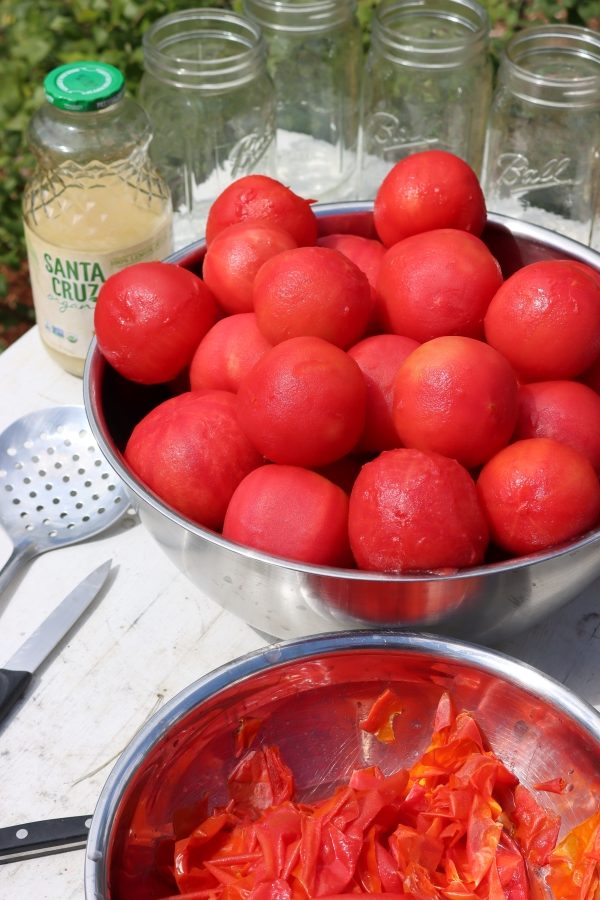
Core and quarter the tomatoes. Then, boil them for 20 minutes in a large, uncovered saucepan.
Run The tomatoes through a sieve or food mill. I often use the food mill attachment on my kitchenaid mixer, but I’ve also used a small hand crank food mill, a manual countertop food mill and a chinois sieve. They all work just as well.
The main thing here is you’re removing the seeds and creating a smooth tomato sauce. If you don’t want the sauce to be smooth, and you want a few chunks, you can simply squeeze out the seeds by hand and then dice up the tomatoes. Don’t do that with more than half your tomatoes, as you do want a bit of sauce in with your chunks or it’ll end up too thick.
If you don’t have any food mill type things at home, you can seed the tomatoes and then put them into a food processor or blender, or chop them with an immersion blender…or for all manual you can just dice them as finely as you can with a sharp knife.
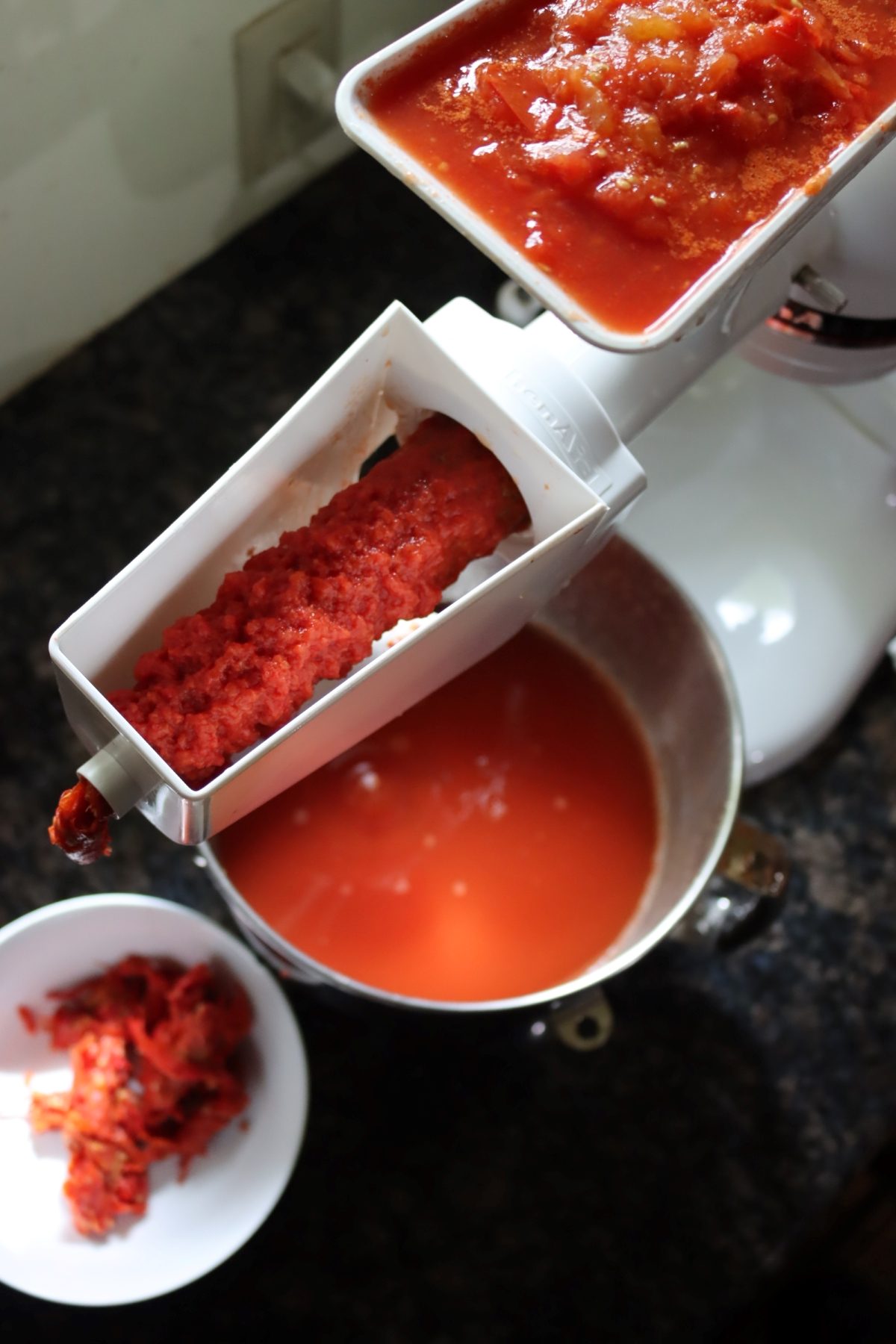
Saute the onions, celery, peppers, mushrooms, and garlic in oil until they are tender. Combine the vegetables with the tomatoes, then add the rest of the ingredients. Bring everything to a boil, then simmer uncovered until the sauce is thick enough for serving.
At this time, you may find that the initial volume of the sauce has been reduced – and that’s fine. It should be reduced to about 50% of its initial volume. Stir often while you’re cooking the sauce to prevent it from burning and sticking to the bottom of the pan.
While the sauce is cooking, prepare a pressure canner along with jars and lids. Follow the instructions from your canner manufacturer, but for most canners, that means adding 2-3 inches of water to the bottom of the canner, along with the bottom trivet and bringing it up to a simmer (180 F) for this hot pack recipe.
Once your sauce is ready, fill hot, sterilized jars. Leave 1” of headspace. Wipe the rims of the jars to remove food particles. Add the lids and bands to the jars, then tighten until they are fingertip tips.
Load the jars into the canner.
Turn heat to high, then allow the canner to vent steam for 10 minutes. Add the weight, then process the jars at 11 lbs pressure for a dial gauge canner or 10 lbs pressure for a weighted gauge scanner if below 1,000 feet in elevation. You will process pints for 20 minutes and quarts for 25 minutes. Adjust for altitude as needed (see below).
When the processing time has finished, allow the canner to depressurize on its own. Remove the jars, then allow them to cool for 12 hours. Check the seals before storing.
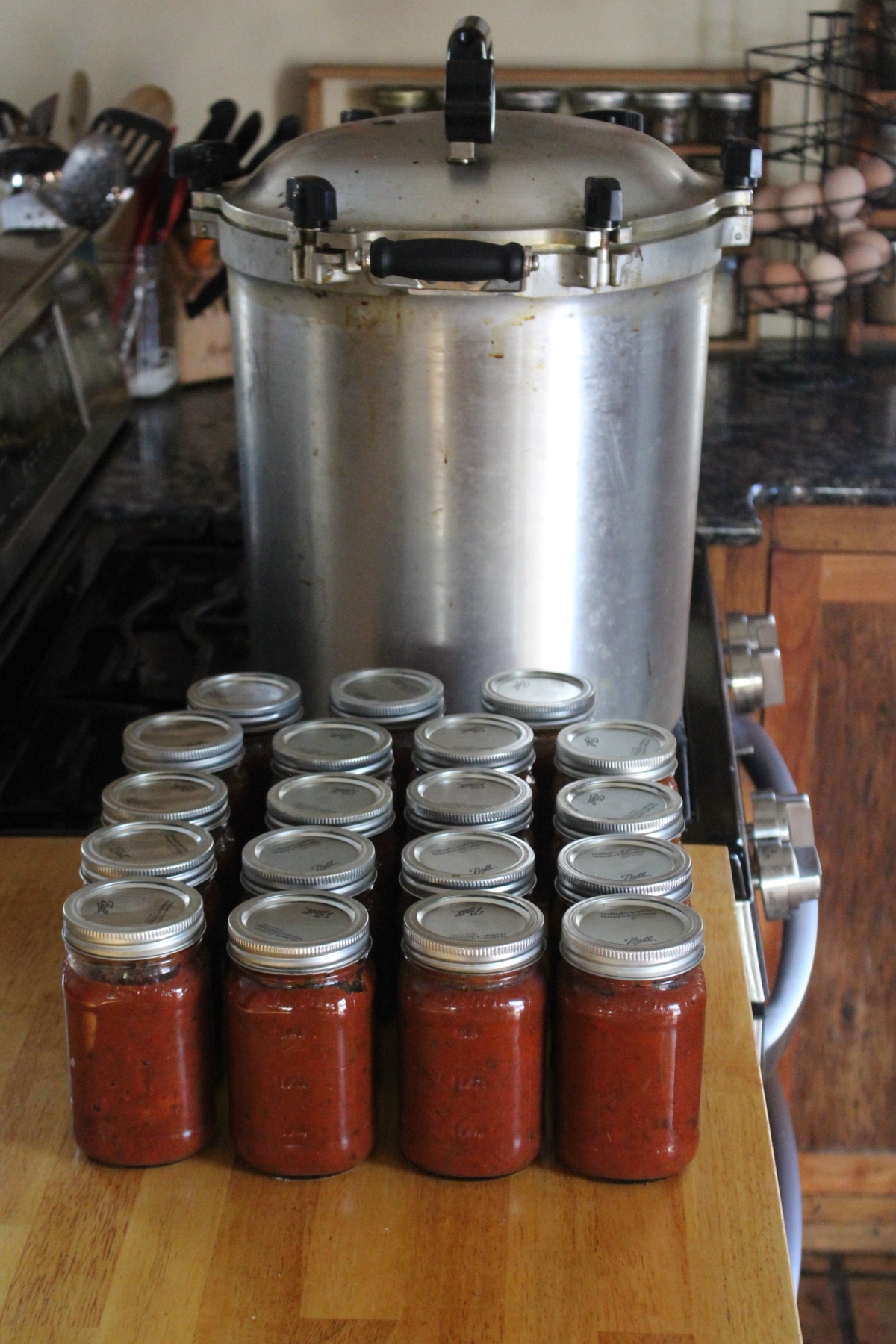
Altitude Adjustments
With pressure canning, the processing times stay the same at higher altitude, but the pressures change. Here are the altitude adjustments for pressure canning spaghetti sauce:
For dial gauge pressure canners:
- 0 to 2,000 feet in elevation – 11 lbs pressure
- 2,001 to 4,000 feet in elevation – 12 lbs pressure
- 4,001 to 6,000 feet in elevation – 13 lbs pressure
- 6,001 to 8,000 feet in elevation – 14 lbs pressure
For weighted gauge pressure canners:
- Above 1,000 feet – 15 lbs pressure
- 0 to 1,000 feet in elevation – 10 lbs pressure
Serving Home Canned Pasta Sauce
This spaghetti sauce is incredibly easy to serve out of the jar – simply heat it up, and you’re good to go.
You can add meat (typically, about half a pound of ground beef or sausage works well per pint, but you can adjust based on your personal preferences) or additional vegetables. If you found that your sauce was a bit on the thin side when you canned it, you may also add thickeners at this point (such as flour or cornstarch).
When it’s time to serve up your sauce, think about pairing it with some whole wheat pasta for a healthier choice – or even some fresh vegetables for an extra punch of flavor.
If you tried this Spaghetti Sauce Canning Recipe, or any other recipe on Creative Canning, leave a ⭐ star rating and let me know what you think in the 📝 comments below!
And make sure you stay in touch with me by following on social media!
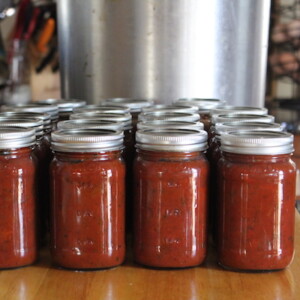
Canning Spaghetti Sauce (Basic Recipe without Meat)
Equipment
- Pressure Canner I use an All American Brand 930
Ingredients
- 30 lbs tomatoes
- 1 cup onions, chopped
- 1 cup bell peppers, or celery, diced
- 1 lb mushrooms, fresh not dried, sliced
- 5 cloves garlic, minced
- 2 tbsp oregano, dried
- 4 tbsp parsley, dried
- 2 tsp black pepper, ground
- 4 ½ tsp salt
- ¼ cup olive oil, or vegetable oil
- ¼ cup brown sugar, optional
Instructions
- Wash the tomatoes. Dip them in boiling water for 30-40 seconds, or until the skins split and pucker. Then, dip in cold water or a bucket of ice and remove the skins.
- Core and quarter the tomatoes. Then, boil them for 20 minutes in a large, uncovered saucepan. Run the tomatoes through a sieve or food mill.
- Saute the onions, celery, peppers, mushrooms, and garlic in olive oil (or vegetable oil) until they are tender.
- Combine the vegetables with the tomatoes, then add the rest of the ingredients. Bring everything to a boil, then simmer uncovered until the sauce is thick enough for serving. Stir often to prevent burning. The sauce should reduce by about half.
- While the sauce cooks, prepare a pressure canner for hot pack, along with jars, lids and rings.
- Once your sauce is ready, fill hot, sterilized jars, leaving 1'' headspace.
- Wipe the rims of the jars to remove food particles. Add the lids and bands to the jars, then tighten until they are fingertip tips.
- Load the jars into the canner.
- Turn heat to high, then allow the canner to vent steam for 10 minutes.
- Add the weight, then process the jars at 11 lbs pressure for a dial gauge canner or 10 lbs pressure for a weighted gauge scanner. You will process pints for 20 minutes and quarts for 25 minutes. Adjust for altitude as needed.
- When the processing time has finished, allow the canner to depressurize on its own.
- Remove the jars, then allow them to cool for 12 hours. Check the seals before storing.
Notes
For dial gauge pressure canners:
- 0 to 2,000 feet in elevation – 11 lbs pressure
- 2,001 to 4,000 feet in elevation – 12 lbs pressure
- 4,001 to 6,000 feet in elevation – 13 lbs pressure
- 6,001 to 8,000 feet in elevation – 14 lbs pressure
For weighted gauge pressure canners:
- 0 to 1,000 feet in elevation – 10 lbs pressure
- Above 1,000 feet – 15 lbs pressure
Nutrition
Nutrition information is automatically calculated, so should only be used as an approximation.
Pressure Canning Recipes
Fill your pressure canner again with these simple pressure canning recipes:
Find the perfect recipe
Searching for something else? Enter keywords to find the perfect recipe!
Meal in a Jar Canning Recipes
Spaghetti sauce is basically a meal in a jar, all you have to do is add cooked pasta. If you’re looking for something that’s more heat and eat, try these meal-in-a-jar canning recipes instead:
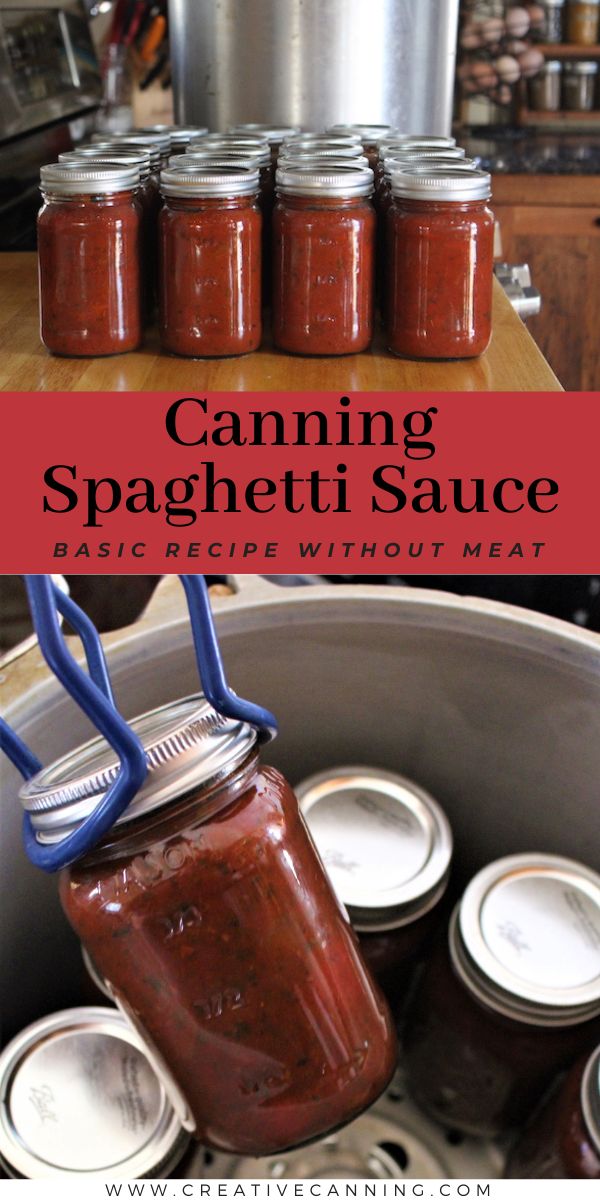
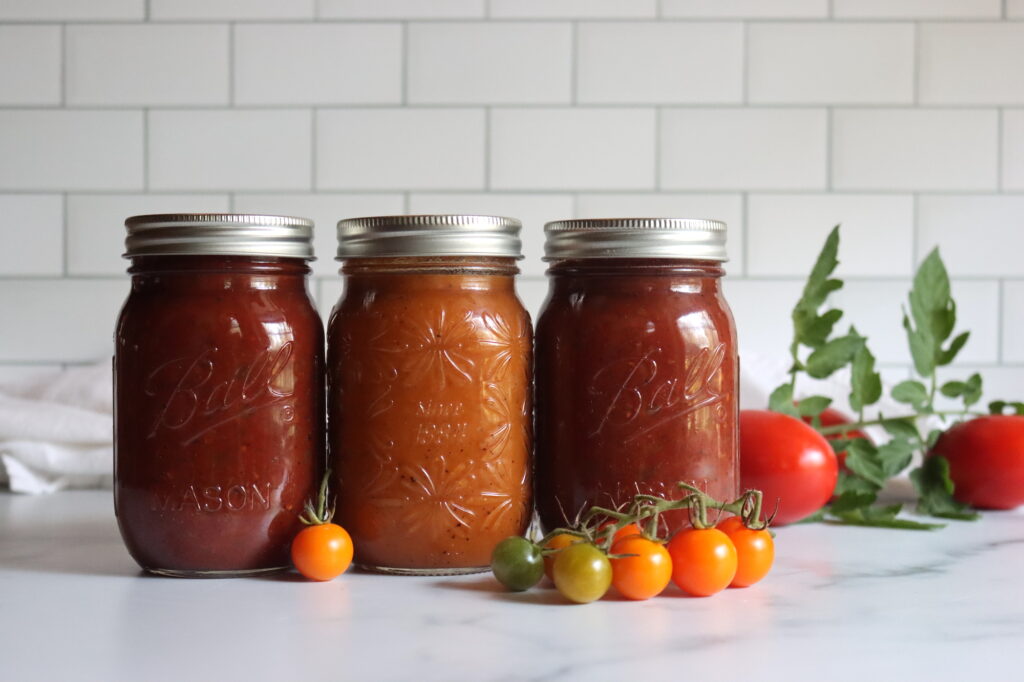
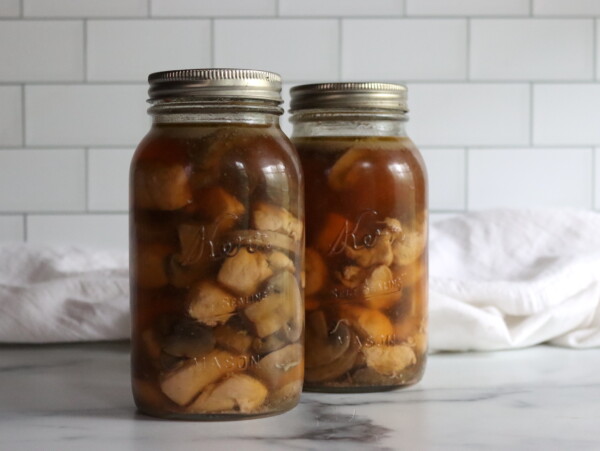
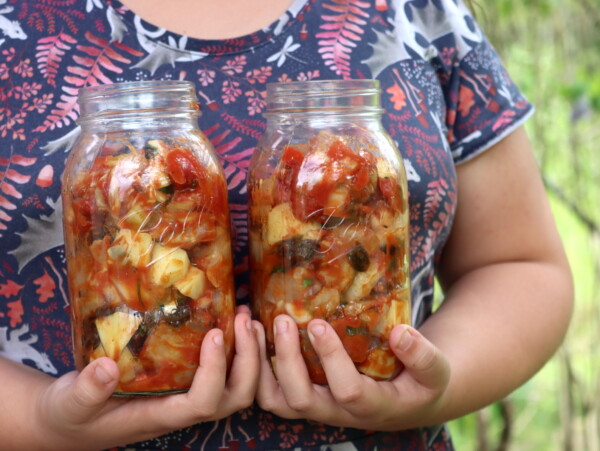
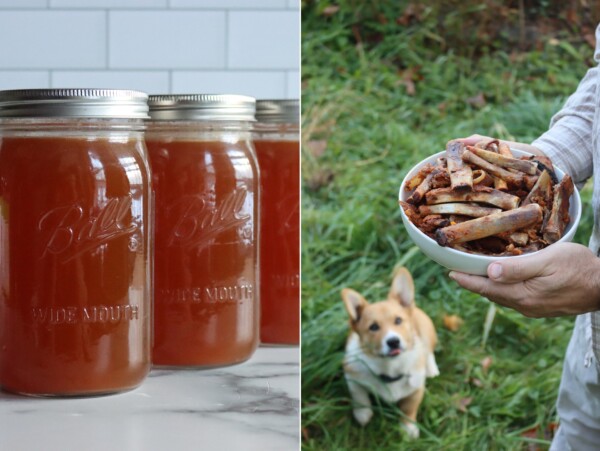
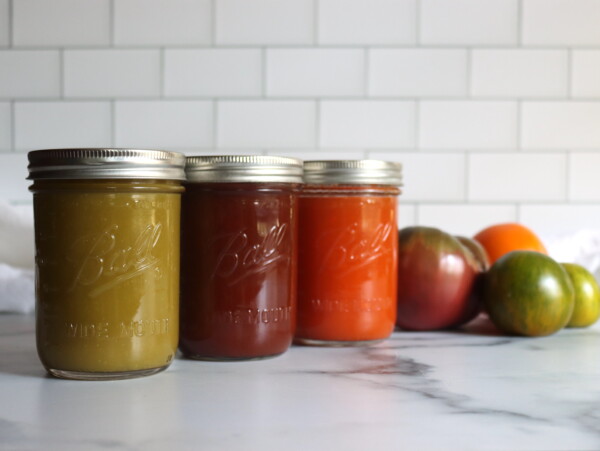
I don’t have a pressure canner. Can I do a water bath if I add lemon juice to the jars before processing?
This particular recipe has too many low acid ingredients to be canned in a waterbath canner (mushrooms, etc). But, there are PLENTY of waterbath canning recipes for pasta sauce. I have a list of all the tested sauce canning recipes out there, and of the 25 recipes, 18 of them are for waterbath canning. You can find that list here: https://creativecanning.com/pasta-sauce-recipes-for-canning/
Enjoy!
How many jars of sauce does this make?
This should make 9 pints.
Hi Ashley,
I am an old time farmer and canner and teach canning classes. I appreciate your website for other recipes. Keep up the good work. I just got done canning lots and lots of jars of blackberry jam.
sincerely,
Heather
Wonderful! I’m so glad it’s useful to you!
Can I increase the mushrooms and decrease the garlic? Garlic doesn’t agree with me.
You can skip the garlic, that’s perfectly fine. For the mushrooms, you can’t increase those. This has a pretty short canning time and that’s based on the fact that it has a lot of acidic ingredients and not many basic ingredients (peppers, onions, mushrooms, etc). If you add more of those you’ll need a much longer process time. There are other tested pasta sauce recipes, and you can find a full list here: https://creativecanning.com/pasta-sauce-recipes-for-canning/
Most don’t have much in the way of mushrooms, largely because mushrooms add so much to the canning time and as a result not many recipes have been tested.
If you want, you can follow the instructions here for canning hearty soups to develop your own mushroom heavy pasta sauce. Know that it’ll have to be pressure canned, and the time will be 75 minutes for pints (rather than the 20 or so for most pasta sauce canning recipes): https://creativecanning.com/choice-meal-in-a-jar-canning-recipe/
The 30 pound of tomatoes, is that before you skin, core and seed them or after? Thanks!
That’s 30 pounds as harvested (or purchased). It’s before processing.
Hi Ashley,
In reading a lot of canned spaghetti sauce recipes, i just couldn’t see that making my own and canning it would make a difference. I didn’t use canned tomatoes or fresh, i used store bought plain canned tomato sauce, browned my meat with some onions and garlic and some italian herb blend added the sauce brought to a boil and cooked to a nice thick sauce. I pressure canned pints for 75 minutes. I still can’t see that i might be in danger. Am i? lol Reading all the instructions don’t add more onions etc etc, does it really have to be so precise?
Thanks in advance!
Pia
All of the tested pasta sauce recipes are pretty precise, mostly because they’re water bath canned or pressure canned for minimal time (as with this recipe). The University of Alaska has instructions for canning hearty soups that allows you to create your own recipe and process it for 75 minutes for pints and 90 minutes for quarts (publication FNH 00065). If you use those processing times in a pressure canner then you can make your own recipe (with or without meat). It sounds like that’s what you have =)
Turned out great! I had never canned spaghetti sauce. The recipe was easy to follow. Thank you!
Wonderful! I’m so glad you like the recipe =)
Can I omit the sugar or use less or will that make it less shelf stable
Yes, you can omit the sugar. It’s optional, and for flavor rather than preservation.
I can’t wait to try this. I am curious why fresh herbs are not recommended. I always use fresh herbs including basil in my sauce when I can it and freeze it. Do they impact the pressure canning process?
Thank you, so much!
In general, canning recipes have you use dried herbs, but in this particular recipe it won’t make much difference one way or another. This one comes from the National Center for Home Food Preservation doesn’t actually specify either fresh or dried.
Is the Oregano and Parsley in this recipe fresh or died?
I always use dried when I make it, but the NCHFP does not specify one way or the other.
Hi Ashley,
Thank you for all of these wonderful recipes!
For this one specifically, you say you can use store bought tomatoes but I do not see any reference as to the quantity needed. Do you know what the quantity would be?
Thanks!
That’s a really great question!
In this recipe you’re making tomato sauce with the tomatoes in a food mill and then cooking it down. According to the University of Georgia, you need about 30 pounds of tomatoes to make 9 pints of a “thick sauce” when you’re making plain unseasoned tomato sauce. I’ve made it, and their thick sauce is about the thickness of store bought stuff.
So if you’re going to substitute here, I’d guess around 9 to 10 pints of store bought canned tomato sauce would be about right. When substituting though, you’ll want to err on the side of more tomato if anything, so if the amounts are in between in canned stuff you can find, round up and add more.
Since the sauce is already cooked down in cans, you’ll want to cook this for less time.
This is a pressure canning recipe without added acidity, so the main thing here is you want the sauce to be thin enough to pour, not pasty. Make sure you have a pourable sauce when it goes into the jars.
I made this sauce today. It took a lot longer than I had anticipated to cook down to the consistency that I wanted. I used Beef Steak, Celebrity and Early Girl tomatoes, so they may have produced more liquid than a meatier tomato would have. I also had a problem getting the seeds out and the next time I make this I’ll remove the seeds when I core my tomatoes. Even though it was a bit difficult for me to make, it is well worth it. This sauce tastes AMAZING!!! I’ll never want store bought sauce again. Thanks so much for this recipe!
Those heirlooms can be a bit seedier than other varieties, and they have a lot more water, so yes, it’ll take a good bit longer to cook down when using those instead of meatier types. Glad you enjoyed it!
Can this be safely made without the oil?
Yes, you can omit the oil without changing the canning safety.
Yes, the oil is optional and isn’t needed for canning safety.
Can I use canned tomatoes? If so how much?
Yes, you can use canned tomatoes. In general, one 14.5 ounce can of tomatoes equals 1 pound fresh. Since this recipe uses 30 pounds of tomatoes, that’s a lot of canned tomatoes, and you might be better off working with bigger cans. In total, you’d need 435 ounces of canned tomatoes. A number 10 can is about 105 ounces, so you’d need about 4 no. 10 can of canned tomatoes to make this whole recipe.
Can both celery and bell pepper be used in this recipe? Or just one or the other?
You can use both, but the total amount cannot be more than 1 cup combined.
Can you use both green pepper and celery in this recipe, or just one or the other? (ie 1 cup bell pepper and 1 cup chopped celery)
You can use a mix, but the total amount can’t be more than 1 cup. So it’d be 1/2 cup green bell pepper and 1/2 cup celery.
Do you not use vinegar or lemon juice to prevent botulism?
Not in this recipe. Most sauce recipes and tomato recipes in general do add lemon juice or vinegar, but this is a tested pressure canning recipe from the National Center for food preservation that was specifically developed with that in mind so you don’t have to put added acidity into the sauce. They also have water bath canning recipes, and those you do need to add acidity. Some of their pressure canning recipes even include the added lemon juice…but not this one in particular. This is their basic recipe for canning spaghetti sauce without meat and the way it was developed it does not include bonus acidity, which is nice, it doesn’t come out too sour.
If I dice part of the tomatoes instead of milling them all, do I still need to remove the skins? When I’m making tomato sauce from fresh tomatoes I usually just dice them and cook them. Not sure if something about the canning would make that… undesirable? Thanks! I just discovered your website and I’m looking forward to trying some of these!
From a safety perspective, you don’t have to peel the tomatoes or mill them. It’s perfectly fine to use diced tomatoes (or part diced tomatoes).
Some people find that some varieties of tomatoes get bitter when you can the peels, and/or the peels are really tough when canned. That really hasn’t been my experience with most the types of tomatoes I’ve canned, but I’ve heard it from many people, so it just depends. It’s a personal preference thing, and you can do just as you say and dice the tomatoes instead. Enjoy!
I use a blender to puree the tomatoes then I use a mesh strainer. I pour in batches and use a spatula to mush the pulp through leaving seeds and any skin that didn’t fully come off tomatoes. Only sauce my kids will eat is home made. Crazy
Can I reduce the amount of salt for this recipe, or will that affect its shelf life?
Yes, you can reduce the salt in the recipe; that’s for flavor rather than preservation. Enjoy!
Can’t wait to try. Could.i cut the tomatoes, juice.them to remove seeds and skin and then cook them down? I’ve seen recipes like that.. I have a juicer.
Also about how many quart jars will this make? Thanks!
If the juicer is only removing the seeds and skins, then it may work. My juicer also removes the pulp though, which is most of the bulk of the tomato. What your really want here is a food mill or chinois sieve.